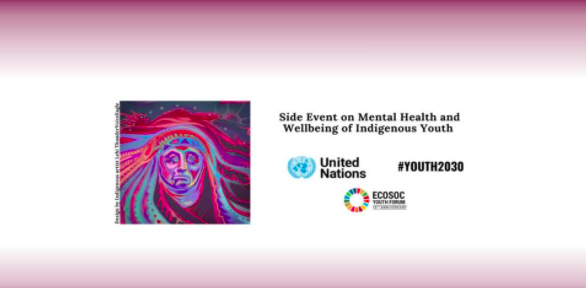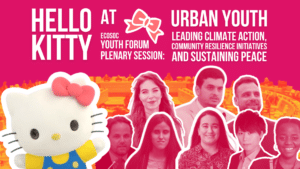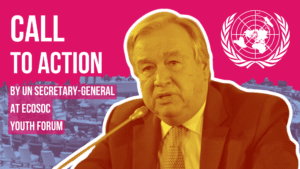10 April 2021, Nairobi. – Youth mental health and well-being is a crucial topic globally, particularly today, due to the circumstances of the COVID-19 pandemic. This has been greatly influenced by the increased loss of jobs, unemployment, lack of access to basic resources, increased inequality and uncertainty of the future among others. However, Indigenous young people across the globe have limited access to such valuable discussions on mental health and wellbeing despite being the most vulnerable compared to non-native youth.
Statistics show that Native youth are 2.5 times more likely to experience trauma than non – Native youth and approximately one in every five Indigenous young adults have a substance use disorder in the US. As a result, the suicide rates among indigenous youth is high and will continue increasing if this vulnerable group’s voices aren’t heard and action taken to ensure that they are more resilient.
On April 6th, a side event on Indigenous Youth Mental Health and Wellbeing was held, during the 10th ECOSOC Youth Forum, with an objective of providing a platform in which the Indigenous youth can be an active part of the global fight against mental health and wellbeing problems and ensure that their voices are heard by global organizations, local and national governments.
Hosted by UN-Habitat, UNMGCY and the International Indigenous Youth Council, the side event brought on 9 renowned Indigenous leaders and activists from across the globe attracting more than 696 views on the live event.
Among the speakers was a 9 year old Environmental Activist, Licypriya Kangujam, who expressed how her life, as an indigenous person, has been affected by the climate change deterioration denying her childhood right in growing up in an air pollution free area in her home country. She further expressed on how the climate change has exacerbated the mental health and wellbeing issues of indigenous persons leading to decrease in their population.
‘Climate change and indigenous activists need to work together as we are fighting for the same goal. A goal on creating a conducive environment for the thriving and preservation of the mental health and wellbeing of indigenous persons, ‘ said Licypriya Kangujam, Environment Activist in India
It was established that the COVID-19 pandemic has exacerbated the challenges faced by the indigenous youth during pre-covid. That is, worsened economic conditions have greatly impacted the Indigenous youth mental health and wellbeing as a large number of the them were already living in unstable conditions of poverty and, lack of access to basic services such as food, health services, housing insecurity among others.
‘States must work in full cooperation with first nations and indigenous persons to fully address the multitude of the socio-economic issues and gaps and ensure that the inherent rights of indigenous persons are upheld and respected, ‘ said Chief Judy Wilson, Chief of Neskonlith Tribe in British Columbia, Canada.
Frank Animikwam, Native American Medical Doctor, highlighted that indigenous youth have been under-represented in the research on mental health and wellbeing. Thus, limited health services and programmes have been aligned to address the mental health and wellbeing issues indigenous people face. This called for the advocate for indigenous community participation in the research and decision-making process on the mechanisms that work in addressing the indigenous persons’ mental health and wellbeing issues.
Indigenous youth should be provided various platforms to express themselves and voice out their issues. Lehi ThunderVoiceEagle, Indigenous Artist, advocated for indigenous youth engagement in the practice of art and creativity that resonates with their community as this allows them to express themselves.
The event ended at a high note with the following recommendations being made:
– Indigenous youth must be involved in the political decision-making processes that determine their living conditions and be at the forefront of such conversations through both grassroots and governmental advocacy. Youth leadership programs are helpful initiatives for this;
– Indigenous peoples’ right to autonomy and self-determination must be exercised, for which states must work with indigenous youth and community leaders in the political decision-making process concerning the affairs of indigenous people. For the improvement of mental health, indigenous communities must be a reflection of their indigenity;
– Increased community integration, cultural connection, provision of creative outlets, equitable access to socio-economic resources, and connection with nature are potential solutions to improve the mental health and wellbeing of indigenous youth.
– The interests of nature and all people’s wellbeing must be at the forefront when combating climate change, as opposed to financial motivations;
– There must be increased access to broadband connection and technical equipment (e.g. computers) for indigenous youth, so that no child or teenager is left behind during virtual education;
– Art and creative practices resonate with indigenous communities and allow young people to express themselves and the direction they envision for themselves and their communities;
– When treating indigenous youth for mental health and wellbeing, patients must be looked at holistically, for which indigenous traditional healing methods and culture must be integrated into healthcare. Nature should also be incorporated into treatment methods.
To learn more about the event, please watch the recording on Facebook.



